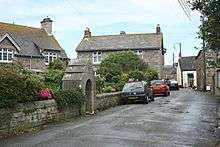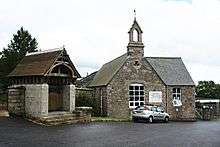Madron
Coordinates: 50°07′59″N 5°33′54″W / 50.133°N 5.565°W
| Madron | |
 Madron Parish Church |
|
| Population | 1,591 (2011 census) |
|---|---|
| Civil parish | Madron |
| Unitary authority | Cornwall |
| Ceremonial county | Cornwall |
| Region | South West |
| Country | England |
| Sovereign state | United Kingdom |
| Post town | PENZANCE |
| Postcode district | TR20 |
| Police | Devon and Cornwall |
| Fire | Cornwall |
| Ambulance | South Western |
| EU Parliament | South West England |
Madron (Cornish: Eglosmadern) is a civil parish and village in west Cornwall, England, United Kingdom. It is a large rural parish on the Penwith peninsula north of Penzance. It is bounded by the parishes of Sancreed and St Just to the west, by Zennor and Morvah to the north, by the sea and the parish of Paul in the south and by the parishes of Gulval and Penzance to the east. Madron village is centred on an elevated site approximately two miles (3 km) northwest of Penzance town centre.[1] The main villages and hamets are Tredinnick, Lower Ninnes, New Mill, Newbridge and Tregavarah. The population was 1,466 at the 2001 census,[2] rising to 1,591 at the 2011 census.[3] The parish church, is in the churchtown and is dedicated to Madron (or Madrona) (in local dialect "Maddern"). The word Modron appears in Cornish and Welsh literature, Modron being the mother goddess, mother of Mabon (after whom the parish and village of St Mabyn is named).
History
Evidence of early medieval habitation at Madron is in the form of one or two inscribed stones. One was found in the wall of the village church and has since been removed; the inscription consists of a cross and legible text, but its meaning is not clear. The other inscription was reported by R. A. Stewart Macalister in 1949 as being 'built into the N. wall of the N. aisle, west of the entrance door' of the church, but has not been seen since; Elisabeth Okasha speculates that Macalister may have seen the inscription in another church, and misremembered its location.[4] Langdon (1896) records eight stone crosses in the parish, of which one is in the churchyard and one is at Heamoor.
Madron was recorded in the Domesday Book. It was within the Manor of Alverton, an area that in the Anglo-Saxon and medieval period formed much of what is now the southern part of west Penwith. The church itself was once under the control of the Knights Hospitallers of Jerusalem[5] and was known by the Cornish name of Landithy, a name which is still used in parts of the village today.
Madron Well was, until the 18th century, the principal source of water for the nearby town of Penzance and Madron Church was the mother church of Penzance.
Admiral Lord Nelson
The news of the death of Vice Admiral Horatio Nelson following the Battle of Trafalgar in 1805 was received first in Britain by the arrival of HMS Pickle en route to Falmouth under the command of Lieut. John Richards Lapenotiere in Mount's Bay. It is believed a fishing vessel from Penzance passed the news to the shore which was formally announced from the balcony of the Assembly Rooms (now the Union Hotel) in Chapel Street, Penzance. Since the mother church of Penzance was at Madron, the mayor of Penzance took up a procession which made its way to Madron where a memorial service was held and the Nelson banner was paraded for the first time. On it was the epitaph "Mourn for the brave, the immortal Nelson's gone. / His last sea fight is fought, his work of Glory done". Storms in the English Channel meant that Nelson's body did not arrive by sea in London until January 1806. However subsequent literature on the Union Hotel and Madron Church makes no mention, of these events, and it is not recorded in the Borough records or the Royal Cornwall Gazette, the only Cornish newspaper at that time.[6] An annual Trafalgar Service commemorating the death of Nelson was started on 27 October 1946 when so many people attended that the service was relayed outside. These services continue to this day.[7] The Trafalgar Fields housing development was so named to reinforce the links with Nelson.
Penzance Workhouse
Once within the parish was the Penzance Union Workhouse. The Penzance Poor Law Union was formed on 10 June 1837 and the population that fell within the Union at the time of the 1831 census was just under 40,000. The Penzance Union workhouse was built in 1838. Designed by George Gilbert Scott and William Bonython Moffatt, it was intended to house four hundred paupers and cost £6,050 to build. It was in use until 1948 when the National Health Service came into being.[8]
Madron today


Landithy Hall, which opened in 1909, contains the Community Rooms and tea rooms where guests can stay the night and hosts many village events. It is here that Madron Parish Council holds the majority of its meetings, the other venue being Trythall School, near New Mill, as well as at St. Maddern's Primary School, below the church in Madron.
Madron Feast Week is from the first Sunday in Advent. The Western Hunt traditionally meets at Madron on Feast Monday and also on Boxing Day.
The village has a Garden of Remembrance for the dead of both World Wars.
Local government
For the purposes of local government Madron elects its own parish council. Under the 1934 restructure of local government the then Penzance Borough Council made representation to include the village of Madron within its boundaries but due to strong local resistance this move was defeated. The nearby settlement of Heamoor (until 1934 part of the parish) was included within the revised boundaries of the borough and remains part of the parish of Penzance to this day.
Schools

Madron Daniell's Endowed School was built by George Daniell in 1710 (his family were Lords of the Manor of Alverton for part of the17th-century.[9] The school is next to the parish church with a view over Penzance and Mount's Bay and has a cottage for the headmaster on site. The school was extended from the original two classrooms to its current size in the late 1960s. It has subsequently been renamed St Maddern's Church of England School.
Playing field
The village has a King George V Playing Field which is home to Madron Football Club. Previously it has been home to both Madron Cricket Club and the Penzance & Newlyn Rugby Club 2nd XV.
Buildings and gardens
- Madron Well

The nearby Madron Well is an example of a Cornish Celtic sacred site, which is renowned for its healing properties. A May Day tradition, which was still being observed in 1879, was for many young folks (mainly girls) to head from Penzance before sunrise, to perform a ceremony, to learn the number of years they have to wait before they get married. Two grass stems or straw, each about an inch long were fastened together with a pin and dropped into the water. Any rising bubbles denote the number of years before they get married. The ceremony was no longer held on May Day, but on a Sunday, because the girls work during the week.[10] A tradition at this site persists to this day whereby people attach pieces of rag (clouties) to the nearby bushes as a symbol of appeasement to the spirits within the well site (see also Clootie well). According to The Cornishman newspaper this tradition was no longer carried out in 1879.[10]
Until the 18th-century it was the only source of water for Madron and Penzance.
- Madron Baptistry
A short distance away is the ruined well-chapel (also known as Madron Baptistry) which has been dated to the 6th-century, but is likely to have even earlier foundations. The building measures 7 metres by 5 metres and has no roof, and it is not known if it ever had a roof. Ivy and wild roses creep over the walls and ferns grow from between the granite blocks. It is a classical site for the nationally scarce, Cornish moneywort (Sibthorpia europaea).[11]
Spring water, from the same source as the original well, is fed into a stone basin in the south-western corner. A low altar stone may be seen against the eastern wall, and stone seats line the walls.
 The baptistry near Madron Well
The baptistry near Madron Well Basin in the south-west corner of the baptistry
Basin in the south-west corner of the baptistry Altar at the eastern end of the baptistry
Altar at the eastern end of the baptistry A wayside cross, Boswarthen (near Madron Well)
A wayside cross, Boswarthen (near Madron Well)
- Trengwainton Garden
Trengwainton Garden, a National Trust property has its closest village as Madron.
Notable residents
- Nessie Dunsmuir (1909–1999), poet
- William Sydney Graham (1918–1986), poet and husband of Nessie Dunsmuir, a plaque in Fore Street commemorates him
- Alfred Wallis (1855–1942) artist, died in Madron workhouse
- David Neil Liddiard Jenkin (born 1943), Cornish Wrestling and Judo Champion, Great Britain Wrestling (Sombo) and British Judo Council (England) representative. Coach to the British wrestling (Sombo) team at the World Games |Den Haag]], 1993. British Judo Association National vet's under 78 kilo champion 1990/91. European (IBF) Open and Middleweight Judo champion. World Sombo (U81k) silver medallist. Attended Madron School and Lescudjack County Secondary, Penzance. Represented the University of Heidelberg (Ruphrects Karl) at the German student judo championships, Aachen, 1971. Son of Leonard and 'Poppy' Jenkin.
References
- ↑ Ordnance Survey: Landranger map sheet 203 Land's End ISBN 978-0-319-23148-7
- ↑ 2001 UK Census
- ↑ "Parish population 2011.Retrieved 10 Feb 2015".
- ↑ See the discussion and bibliography in Elisabeth Okasha, Corpus of Early Christian Inscribed Stones of South-west Britain (Leicester: University Press, 1993), pp. 178–84
- ↑ "Madron (H)". West Penwith Resources.
- ↑ Pool, P. A. S. (1974) The History of the Town and Borough of Penzance. Penzance: Corporation of Penzance.
- ↑ "Madron calendar of social events 2011". Madron and Gulval Parish Churches. Retrieved 9 July 2011.
- ↑ http://madronparishrecords.tripod.com/id53.html
- ↑ Pool, Peter A S (1974). The History of the Town and Borough of Penzance. Penzance: Corportation of Penzance. ISBN 978-0905375007.
- 1 2 "Madron Well. May Day There". The Cornishman (43). 8 May 1879. p. 4.
- ↑ French, Colin N; Murphy, Rosaline J; Atkinson, Mary G C (1999). Flora of Cornwall. Camborne: Wheal Seton Press. ISBN 978-0953461301.
- Dundrow, Michael (2001) Madron's Story (with Margaret Dundrow and ---- Jenkins)
External links
| Wikimedia Commons has media related to Madron. |
- Canon Jennings – Some Notes on Madron Registers, 1929
- Madron Parish Council website
- Cornwall Record Office Online Catalogue for Madron
- The history of the Count House of Ding Dong Mine